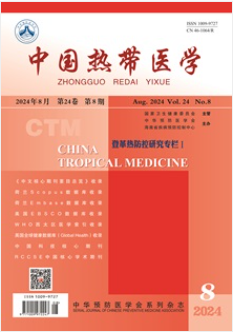2012 - 2019年广西中越边境吸毒人群HIV、HCV感染状况及相关危险因素分析
引用次数: 0
摘要
目的了解广西中越边境地区吸毒人员HIV、HCV及HIV/HCV合并感染的流行情况及相关危险因素,为该人群的高危干预提供参考。方法2012 - 2019年,每年4 - 6月,采用国家制定的调查问卷,对广西边境地区监测点、社区吸毒人员和美沙酮门诊吗啡尿检阳性者进行连续横断面调查,采集血样检测HIV和丙型肝炎病毒(HCV)抗体。结果2012 - 2019年共监测吸毒人员12 842人。HIV、HCV和HIV/HCV合并感染的总阳性率分别为3.84%、43.34%和3.14%。HIV、HCV及HIV/HCV合并感染率呈逐年下降趋势。不同人口统计学特征的吸毒者患病率存在差异。Logistic回归分析显示,与HIV感染相关的危险因素包括女性、小学教育程度和注射吸毒。HCV感染相关危险因素包括:20岁及以上、离异或丧偶、汉族、壮族以外的少数民族、传统吸毒或混合吸毒、注射吸毒。与艾滋病毒/丙型肝炎病毒合并感染相关的危险因素包括女性、初等教育和注射吸毒。结论广西边境地区吸毒人员HIV感染率和HCV抗体阳性率较高,HIV/HCV合并感染的感染率较低。新型药物的使用呈上升趋势。对女性和老年吸毒人员以及有注射吸毒史的吸毒人员应进行有针对性的有效干预。摘要:目的了解广西中越边境地区吸毒人群中艾滋病毒、丙肝病毒(HCV)及HIV / HCV合并感染情况及其影响因素,为在该人群中开展髙危行为干预提供参考依据。方法2012 - 2019年间每年4一6月,采用国家统一制定的问卷对广西中越边境哨点监管场所,社区和美沙酮门诊最近1个月吗啡尿检阳性者开展连续横断面调査,并采集调査对象血液标本进行HIV和丙肝病毒抗体检测。结果2012 - 2019年共监测12 842名毒品使用者.HIV感染率为3.84%,丙肝病毒抗体阳性率为43.34%,HIV / HCV合并感染率为3.14%。hcv, hcv, hcv, hcv, hcv, hcv, hcv, hcv, hcv, hcv, hcv, hcv, hcv, hcv, hcv, hcv不同 行为特征的吸毒人群感染情况不同。逻辑逻辑(逻辑逻辑)年龄> 20岁,离异或丧偶,除汉族和壮族外的其他少数民族,传统毒品和混合毒品使用者,有注射毒品史是感染丙肝病毒的危险因素。爱滋病毒/丙型肝炎(hiv / hcv)结论广西边境吸毒人群整体艾滋病毒感染率和丙肝病毒抗体阳性率较髙,HIV / HCV合并感染率较低,新型毒品使用者比例呈上升趋势。提示需针对女性、髙年龄 组及有注射吸毒史的吸毒人群开展有效干预措施。本文章由计算机程序翻译,如有差异,请以英文原文为准。
HIV and HCV infection status and related risk factors in drug users at the Sino-Vietnamese border in Guangxi, 2012 — 2019
Objective To understand the prevalence rates and the related risk factors of HIV, HCV and HIV/HCV coinfection in drug users in the Sino-Vietnamese border areas of Guangxi, and we provide reference for high-risk intervention in this population. Methods From April to June every year from 2012 to 2019, a questionnaire developed by the state was used to carry out continuous cross-sectional surveys on the post surveillance sites in Guangxi border areas, community drug addicts and morphine urine test positive persons in methadone clinics in the past month, and blood samples were taken from them for the detections of HIV and hepatitis C virus (HCV) antibodies. Results A total of 12 842 drug users were monitored from 2012 to 2019. The overall positive rates of HIV, HCV and HIV/HCV co-infection were 3.84%, 43.34% and 3.14%, respectively. HIV, HCV and HIV/HCV co-infection rates showed an decrease trend year by year. The prevalence differed in drug users with different demographic characteristics. Logistic regression analysis showed that HIV infection related risk factors included being female, primary education and injecting drug use. HCV infection related risk factors included 20 years old or more, divorced or widowed, minorities other than Han and Zhuang, being traditional drug user or mixed drug user, and injecting drug use. HIV/HCV co-infection related risk factors included being female, primary education and injecting drug use. Conclusion The HIV infection rate and HCV antibody positive rate in drug users in border areas of Guangxi were relatively high, and the infection rate of HIV/HCV combined infection were low. The use of novel type drugs was in increase. Targeted effective interventions should be conducted in female and older drug users as well as drug users having a history of injection drug use. 摘要:目的 了解广西中越边境地区吸毒人群中HIV、丙肝病毒(HCV)及HIV/HCV合并感染情况及其影响因素, 为在该人群中开展髙危行为干预提供参考依据。 方法 2012—2019年间每年4一6月, 采用国家统一制定的问卷对广 西中越边境哨点监管场所、社区和美沙酮门诊最近1个月吗啡尿检阳性者开展连续横断面调査, 并采集调査对象血液 标本进行HIV和HCV抗体检测。 结果 2012—2019年共监测12 842名毒品使用者。HIV感染率为3.84%, HCV抗体 阳性率为43.34%, HIV/HCV合并感染率为3.14%。HIV、HCV及HIV/HCV合并感染率整体上呈逐年下降的趋势。不同 行为特征的吸毒人群感染情况不同。Logistic回归分析显示, 女性、小学学历、有注射吸毒史是感染HIV的危险因素。年龄>20岁、离异或丧偶、除汉族和壮族外的其他少数民族、传统毒品和混合毒品使用者、有注射毒品史是感染HCV的 危险因素。而女性、小学文化、有注射毒品史是HIV/HCV合并感染的危险因素。 结论 广西边境吸毒人群整体HIV感 染率和HCV抗体阳性率较髙, HIV/HCV合并感染率较低, 新型毒品使用者比例呈上升趋势。提示需针对女性、髙年龄 组及有注射吸毒史的吸毒人群开展有效干预措施。
求助全文
通过发布文献求助,成功后即可免费获取论文全文。
去求助
来源期刊
CiteScore
0.60
自引率
0.00%
发文量
13927
期刊介绍:
China Tropical Medicine, was approved by the Ministry of Science and Technology in 2001, is the only tropical medicine periodical under the charge of the National Health Commission of China. It’s organized by Hainan Provincial Center for Disease Prevention and Control, and Chinese Preventive Medicine Association.
The journal is indexed by the following database: Scopus database, Embase database, EBSCO Database, The Western Pacific Region index medicus (WPRIM), American Chemical Abstracts (CA), International Centre for Agricultural and Biological Sciences Research Database (CABI), Global Health Database, Database of the Ulrich's Periodicals Directory, China Science and Technology Core Journals, China Core Journals (Selection) Database, Database of Chinese Biomedical Literature, Comprehensive Evaluation Database of Chinese Academic Journals, CAJCD Code of Conduct Excellent Journal, Database of Chinese SCI-Tech Periodicals, China Journal Full Text Database.

 求助内容:
求助内容: 应助结果提醒方式:
应助结果提醒方式:


